How To Safely Hike In Bear Country (Alberta & BC)

Questions about bear safety are inevitable for any intrepid hiker going on their first hike in bear country. Never fear. Bears should not detract from enjoying a hike, but hiking in their home requires respect and knowledge.
Most bears and wildlife do their best to avoid human interactions. However, every time you go on a hike in Bear Country, there is a chance for a bear encounter. Naturally, bears are fearful of humans, but as they become more accustomed to humans, campers, and hikers, the risk of interaction increases. This means hiking trails are a prime location to come across a bear.
It’s essential to remember that a bear is not hiding in the woods waiting to pounce on unsuspecting hikers. Hiking in Bear Country is about mitigation and preparation. These bear safety tips are all about reducing your chances for interaction and being prepared in case of a negative interaction.
How To Safely Hike In Bear Country
While these bear safety tips apply to hiking anywhere there are bears, we’re writing this with the Canadian Rockies in mind, as many of you visiting Banff ask about hiking in the Rockies specifically.
Respect Closures And Notices
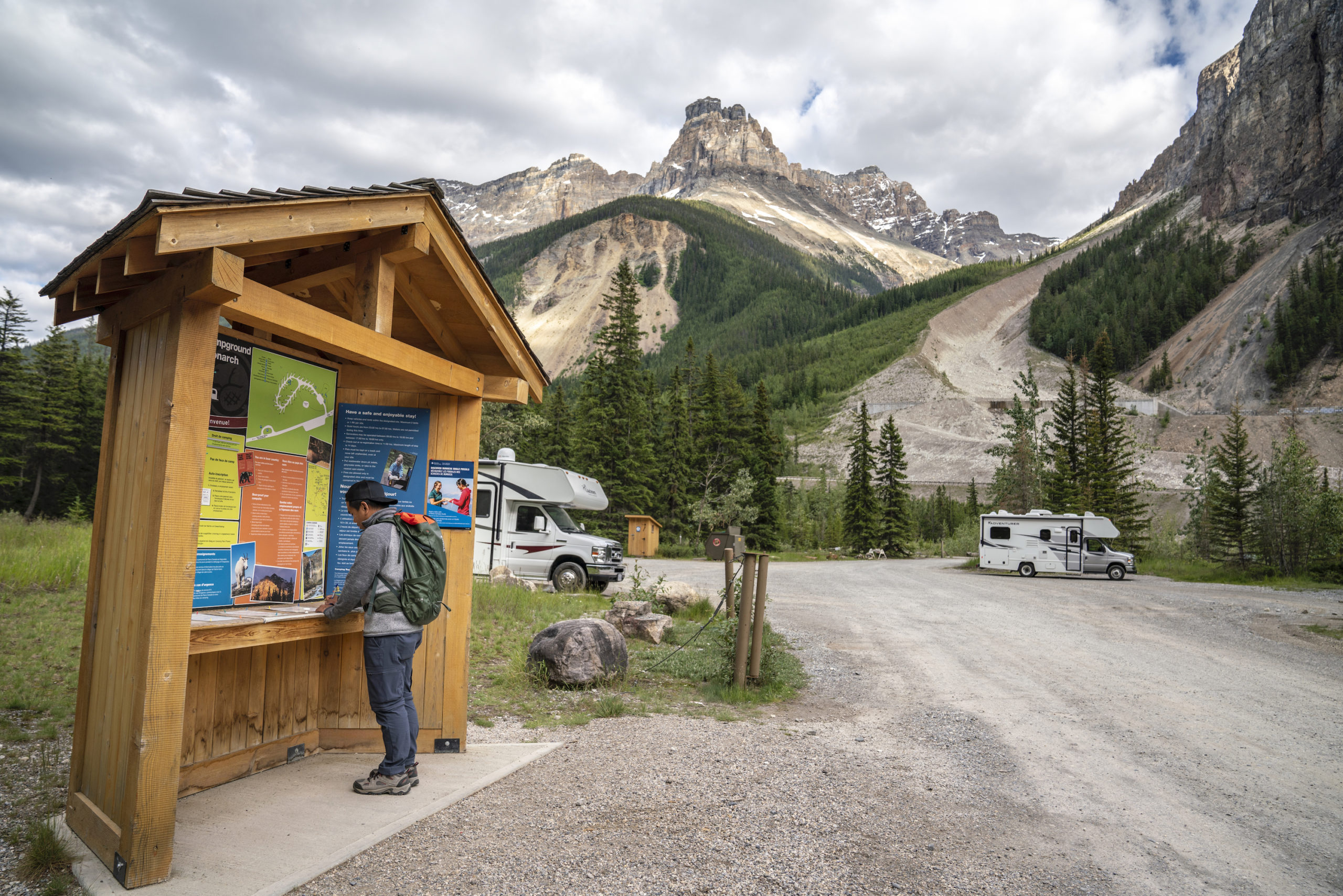
The first tip is to avoid a negative bear interaction altogether. Park wardens often institute trail closures to help mitigate potentially harmful bear interactions. When a bear is seen frequenting an area or a mother and cub are denning near the trail, wardens will close the trail.
Notices are posted online and at the trailhead when the trail or area is closed. You should always adhere to warnings and closures. It’s a good idea to check trail conditions the night before and keep an eye out for any notices posted at the trailhead. I like to head to the trailhead with backup plans for another hike or summit, just in case it was recently closed because of bear activity.
Be Aware Of Your Surroundings
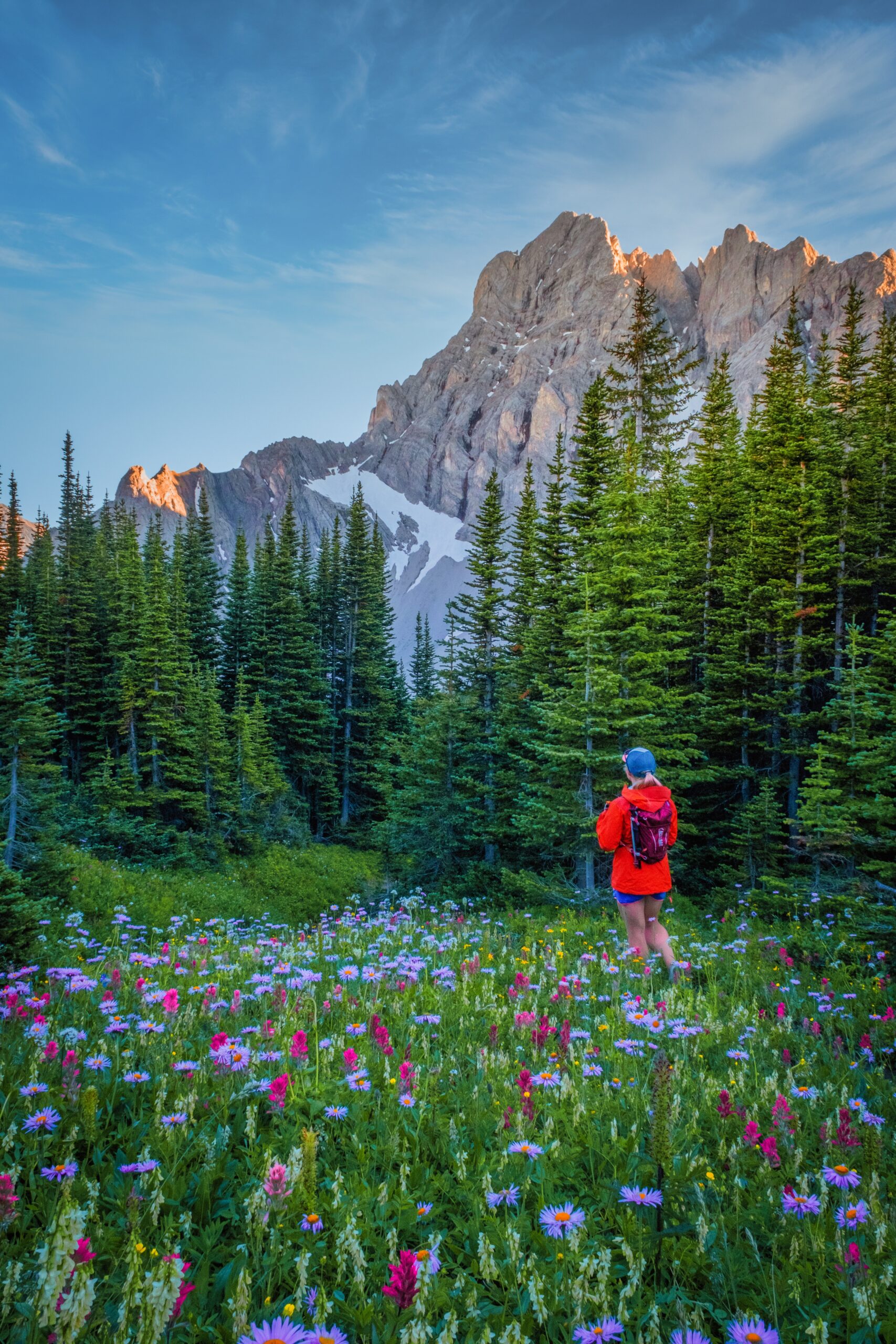
Always be aware of your surroundings when hiking in bear country. First off, do not wear earbuds, which I often see from at least one hiker on every hike we take. When you’re hiking, you need all your senses. You’re there to enjoy nature, so it’s best to leave the music for the gym.
A startled bear is at its most dangerous. It’s best to see a bear before you surprise the animal. Keep your eyes open for fresh tracks, scat, or feeding sites (more on that below).
Watch how the trail progresses and think about headwinds, running water, trail bends, or dense vegetation. A hiking trail is the easiest way to navigate thick vegetation, and bears will use hiking trails too! Exercise caution when your chances of startling a bear increase. This is best done by making noise when a bear may not hear, smell, or see you coming along the trail.
Do not assume that the bear will see you first. Bears sleep for half the year, so they have a limited time to eat a massive amount of food. Meaning you may not break a bear’s focus from a food source.
Make Noise On The Trail
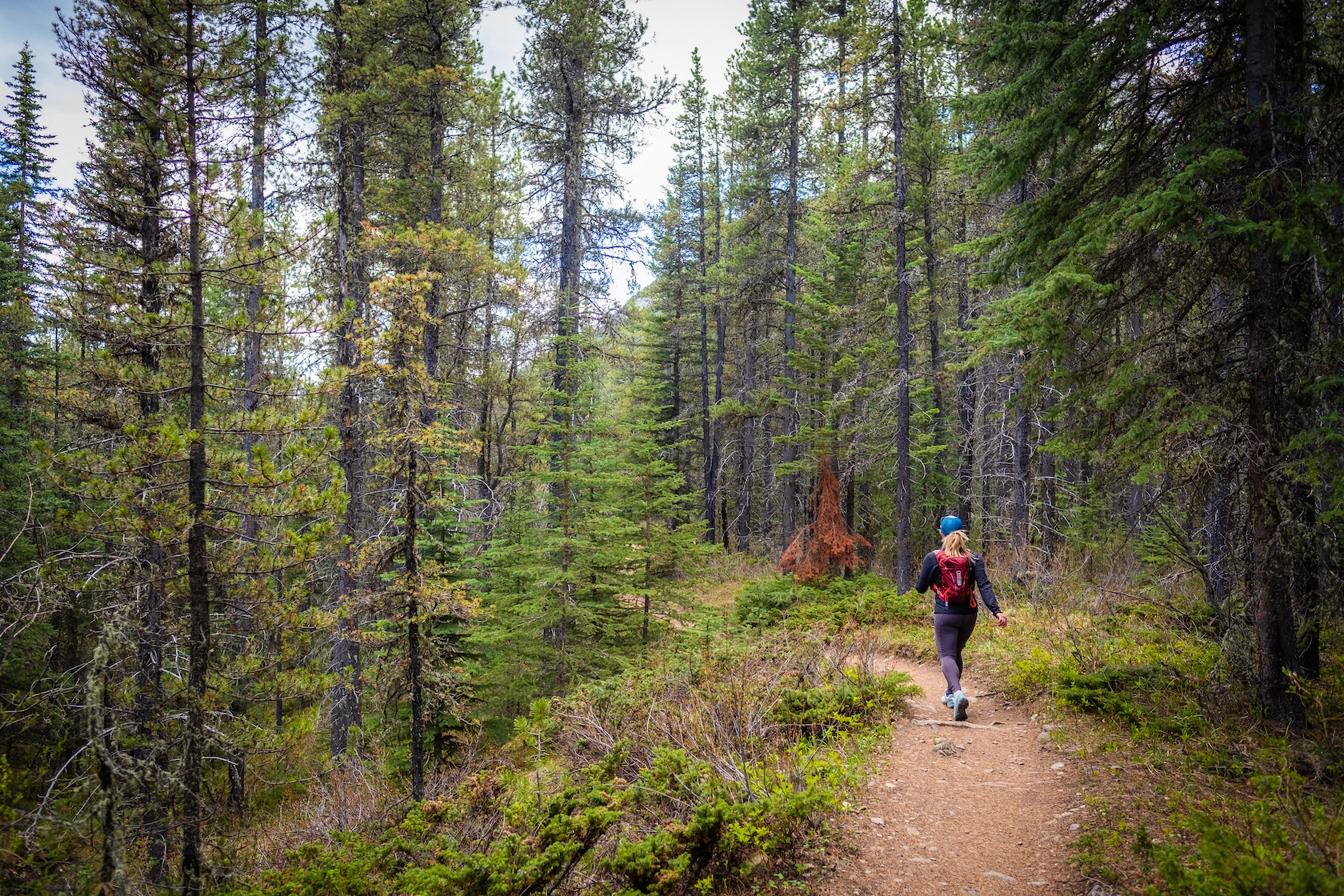
While you’re alert, you should make noise in areas where a surprise bear encounter is possible. Of course, if you’re on a crowded or busy trail, this is likely not necessary. However, it’s good to shout, “Hey bear,” to alert any potential bears in the area on a quiet path.
We don’t say this all the time on the trail but pay extra caution to the areas noted above where a surprise bear encounter is possible. This is typical when we find ourselves on quiet trails. We always make noise or carry on a conversation loudly.
If you’re not sure what to yell or talk about with your hiking partner, we suggest you play a game. It’s helpful after a long day on the trail, and conversation can feel a little difficult. You can also do this yourself; granted; you might seem crazy if you pass anyone!
Keep in mind that you, not bear bells, are the most effective noisemaker in Bear Country. Talking or singing loudly can help prevent surprise encounters with Banff wildlife.
According to Alberta Parks, other types of effective noisemakers are:
- Air horns: These are easily carried in bear country and create a loud, piercing sound of more than 120 decibels.
- Banger cartridges: These are pen or pistol- launchers. They travel 20 to 100 meters (66 to 328 feet) and then create a loud bang.
- Screamers: These create a loud, continuous screeching noise for approximately 100 meters (328 feet). Their flight pattern is erratic, so be extremely cautious when using them.
It’s important to remember
- Do not use bangers or screamers in dry forest conditions as they can cause a fire.
- When aiming the noise deterrent, aim at the sky.
What About Bear Bells?
Bear bells are cheap and may seem like an easy bear deterrent option, but they don’t actually make enough noise to alert wildlife that you are there. Your voice is a far cheaper alternative. In our opinion, they are a bit worthless (and also irritating). However, if you choose to carry bear bells, remember that you must still be Bear-Aware and Smart in other ways.
Utilize Bear Spray
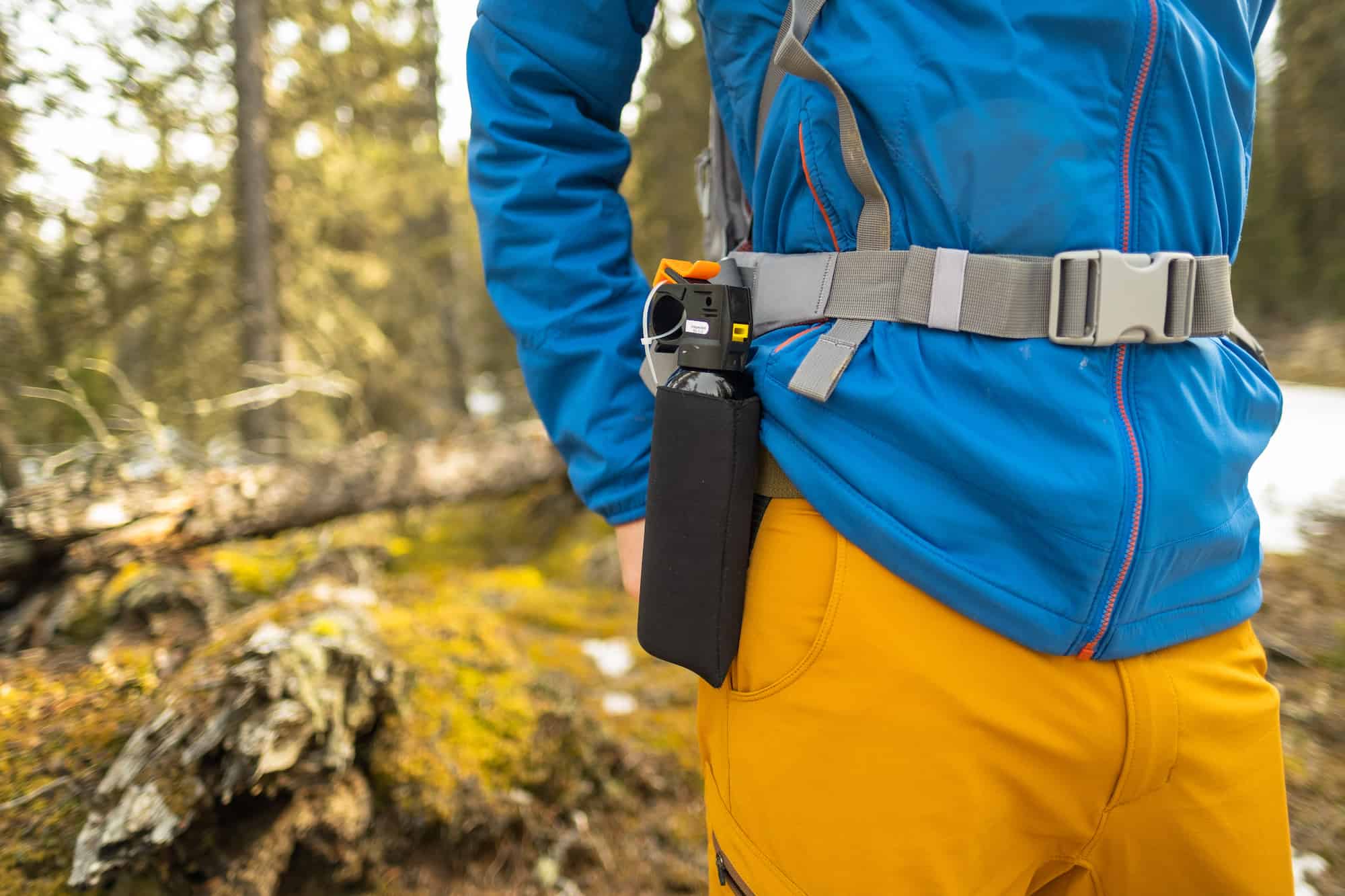
Bear spray is proven to be effective at stopping aggressive bear behavior. A study of Alaskan bear encounters found that 98% of those who used bear spray were uninjured by the bear, and the remaining 2% received only minor injuries that required no hospitalization. The active ingredient in bear spray is oleoresin capsicum, which irritates the eyes, nose, and lungs, causing severe but temporary eye irritation and difficulty breathing for bears (and humans!). It’s not just a deterrent for bears, but other types of wildlife too, such as cougars.
Always carry bear spray and have it readily available in bear country. Carry the bear spray in a belt holster, backpack strap, cargo pocket, or hip belt. Bear spray should never be at the bottom of your pack, as you need to be able to access it quickly in an emergency.
Aggressive behavior will likely occur from startling a bear in which you may only have seconds to react, not a minute to reach into your backpack. The U.S. National Park Service has excellent advice and a video on how to best use bear spray. Most outdoor stores or rental locations will be happy to demonstrate how to effectively use bear spray.
Should you deploy bear spray, be sure to clear the area. Then, alert any relevant authorities to the encounter. Bear spray can attract bears after awhile as it is pepper spray and smells sweet. The information can help park authorities assess the situation with the bear, which may involve trail closures, animal relocation, or on rare occasions, destruction.
Mind Your Gear
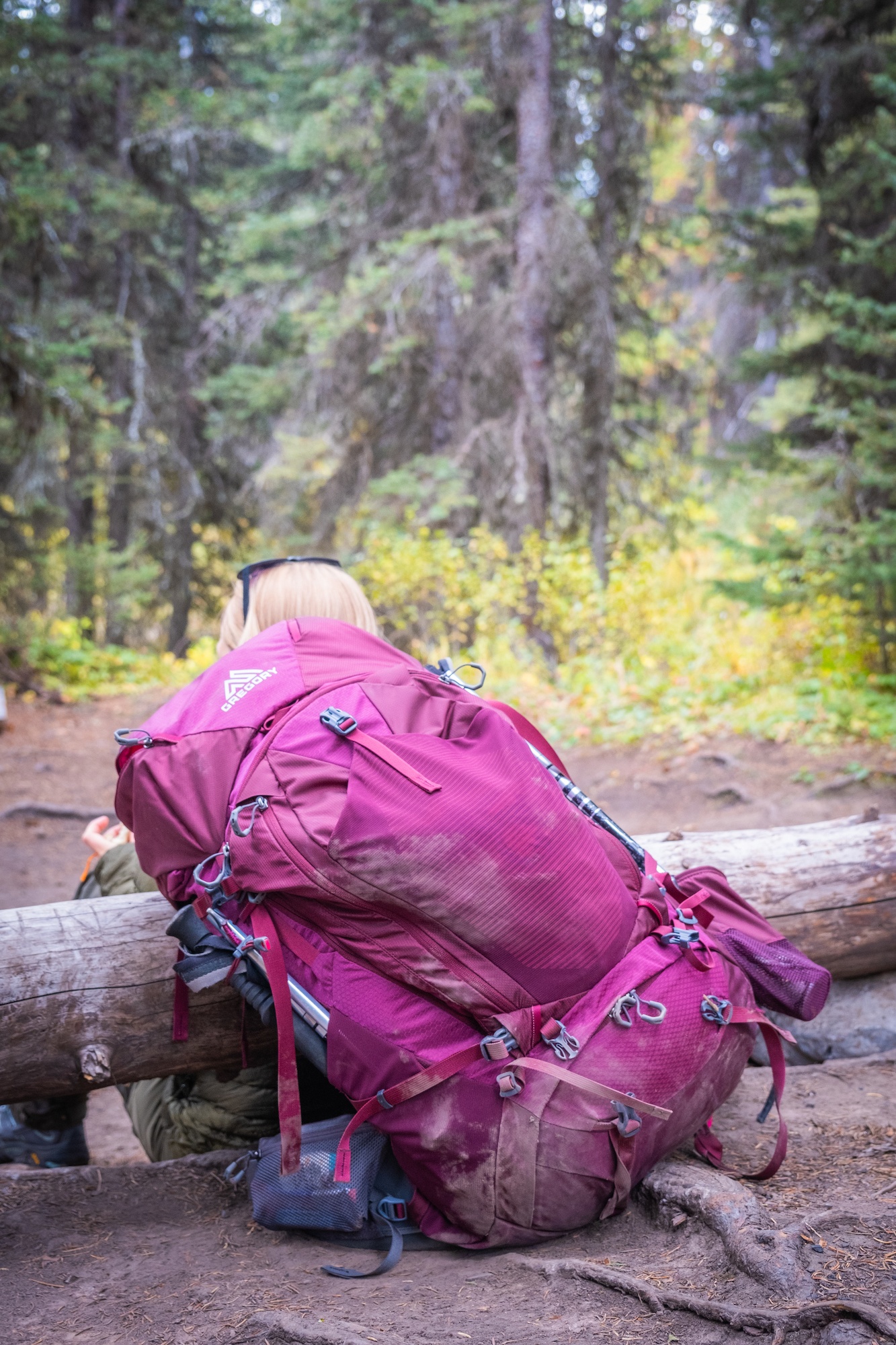
You should never leave your packs or bags unattended for even a few minutes. Bears are intelligent and learn new food sources fast. If a bear receives human food even once, it will often become more aggressive towards people and attempt to loot other packs for food.
This applies to all of your time in the park. Never litter and always utilize bearproof trash cans when disposing of food. When a bear receives human food, it may result in a destroyed bear as it becomes habituated to humans. Keep in mind the classic mantra, “A fed bear is a dead bear.” This applies to all wildlife.
Use Caution Around Bear Food
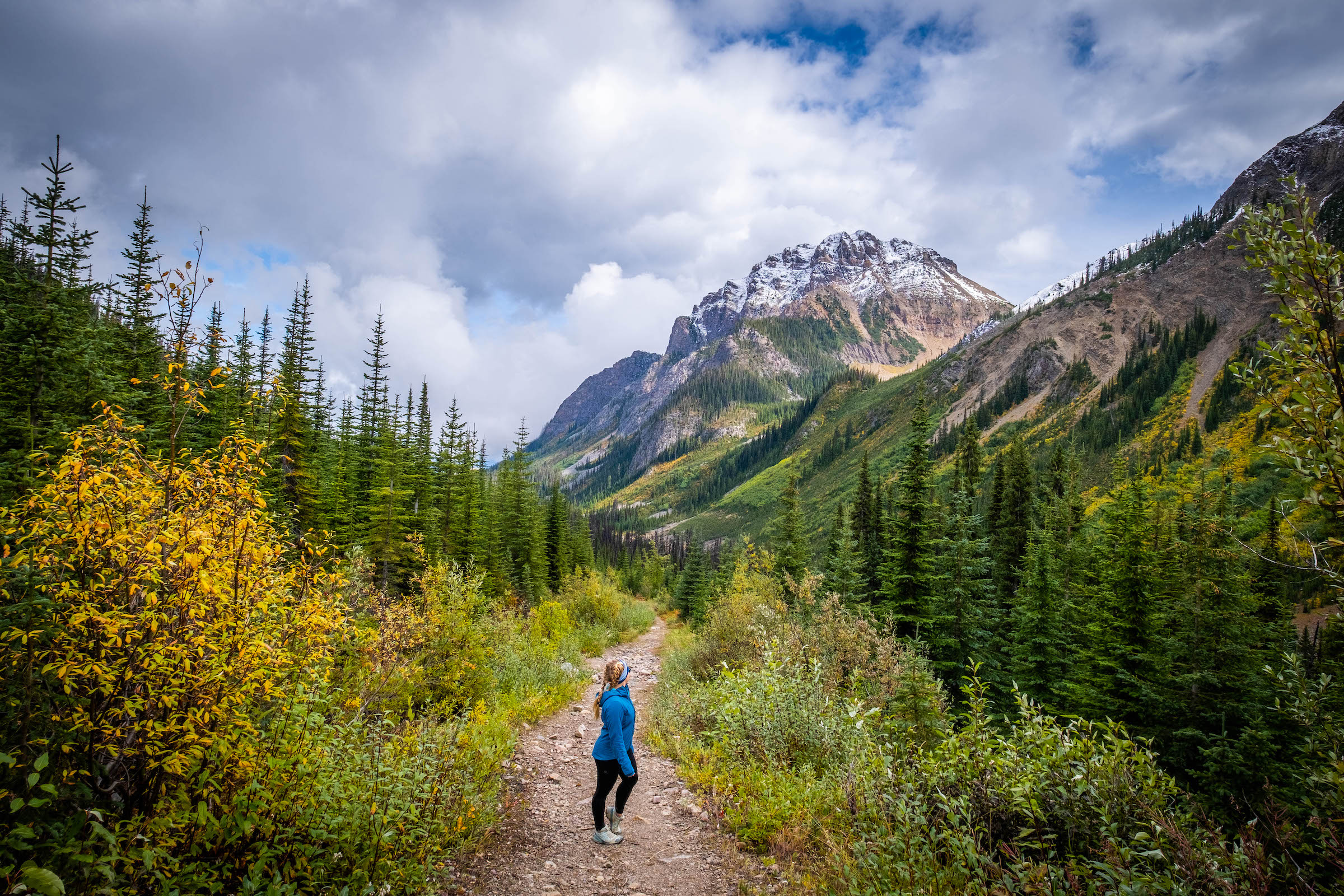
Buffaloberry is the most crucial food source for bears in the Canadian Rockies. This bush thrives in low-lying sunny areas along trails and is the most likely reason for interaction. The bears are in a feeding frenzy when the bushes come into season from July to September. You can recognize the bush from its oblong leaves and dark red berries with tiny white dots.
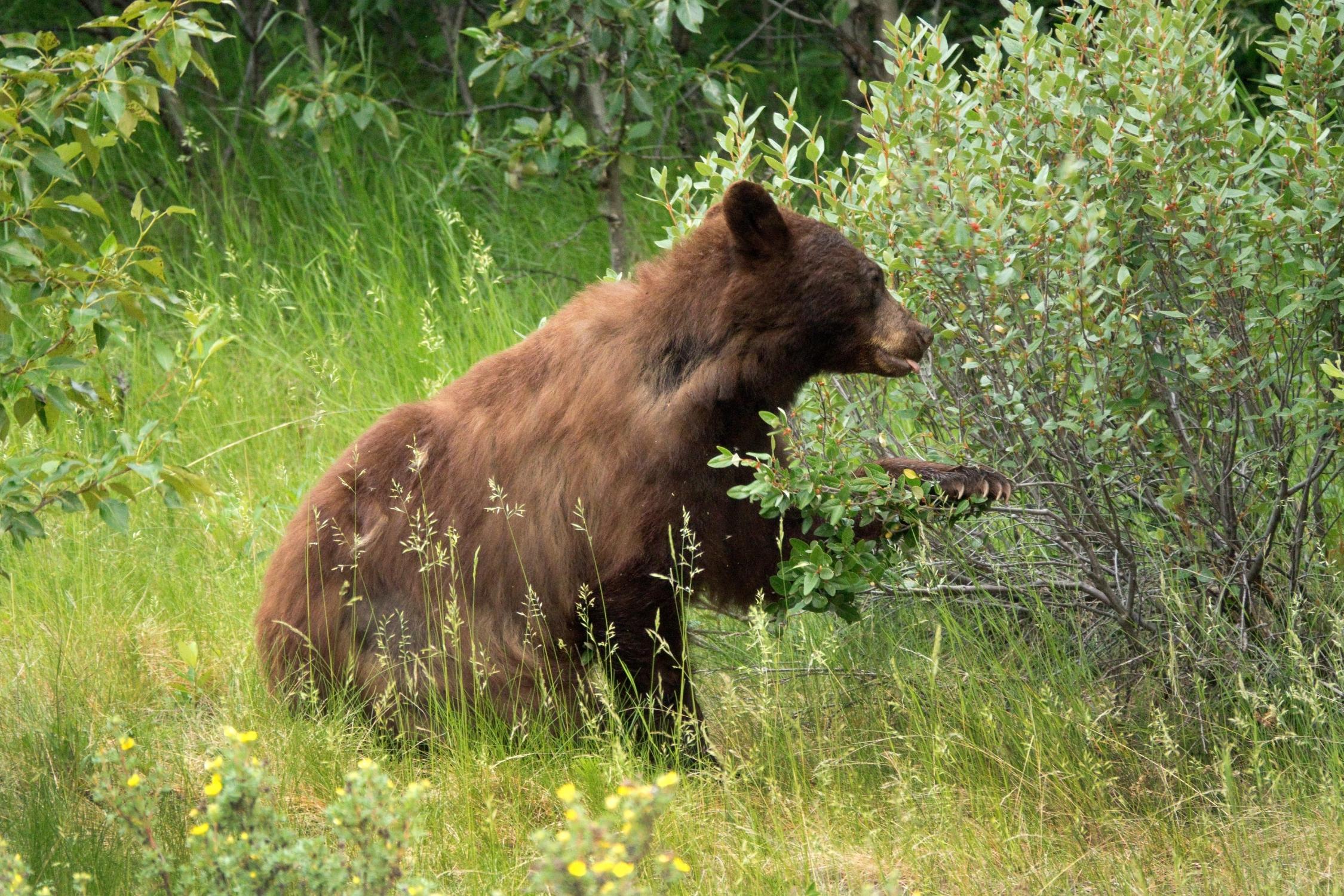
If you’re hiking and come along the bushes, it’s best to practice caution or consider an alternative hike if it’s a seldom-used trail. Another source is to avoid any animal carcasses. If you smell something dead or see birds circling overhead, it’s good to avoid the area. Encroaching on a bear’s prized food source is not advised.
Limit Hiking Solo
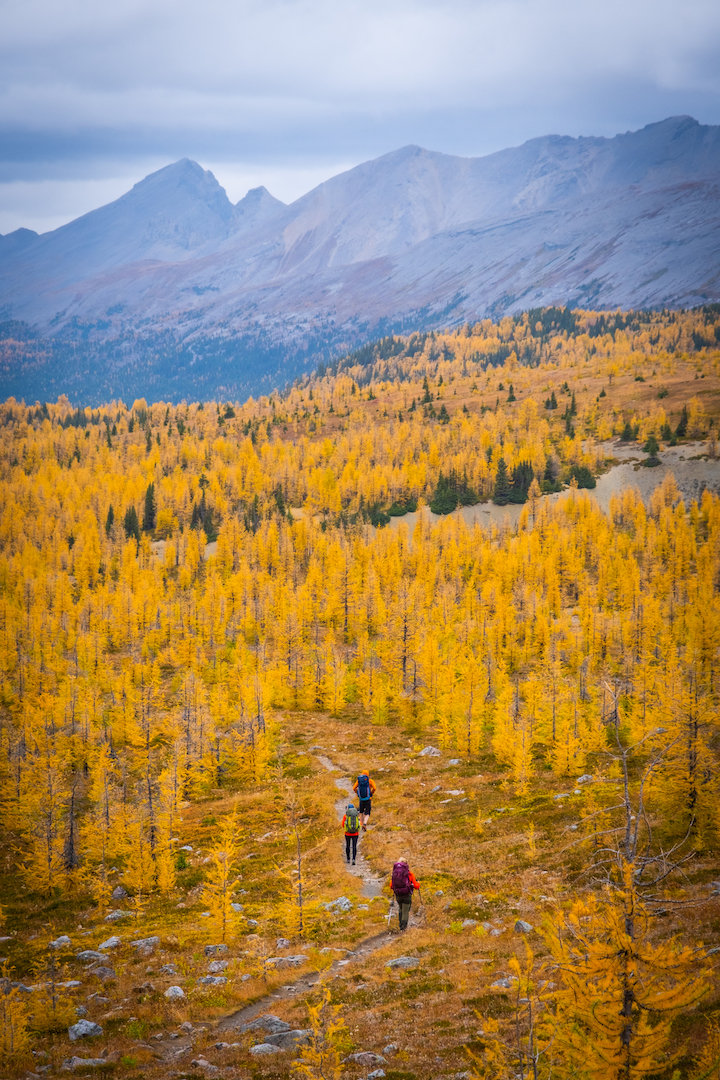
There have been very few bear attacks on groups of four or more. Some sources cite that there has never been a death from a bear attack in groups, but we could not verify that with a reference. However, stats back up that 91% of bear-related injuries have occurred to solo or two hikers while only 9% occurred to groups of three or more in Yellowstone. Groups certainly detract from the chance of a bad interaction with wildlife.
It is intimidating for a bear if you’re in a group of three or more. In addition, since a group is louder, smellier, and larger, they’re far less likely to startle a bear. Safely hiking in Bear Country is about making dozens of decisions to reduce the chance of a negative interaction. It’s rarely just one decision you make on the trail.
Stay Aware of Active Bear Hours
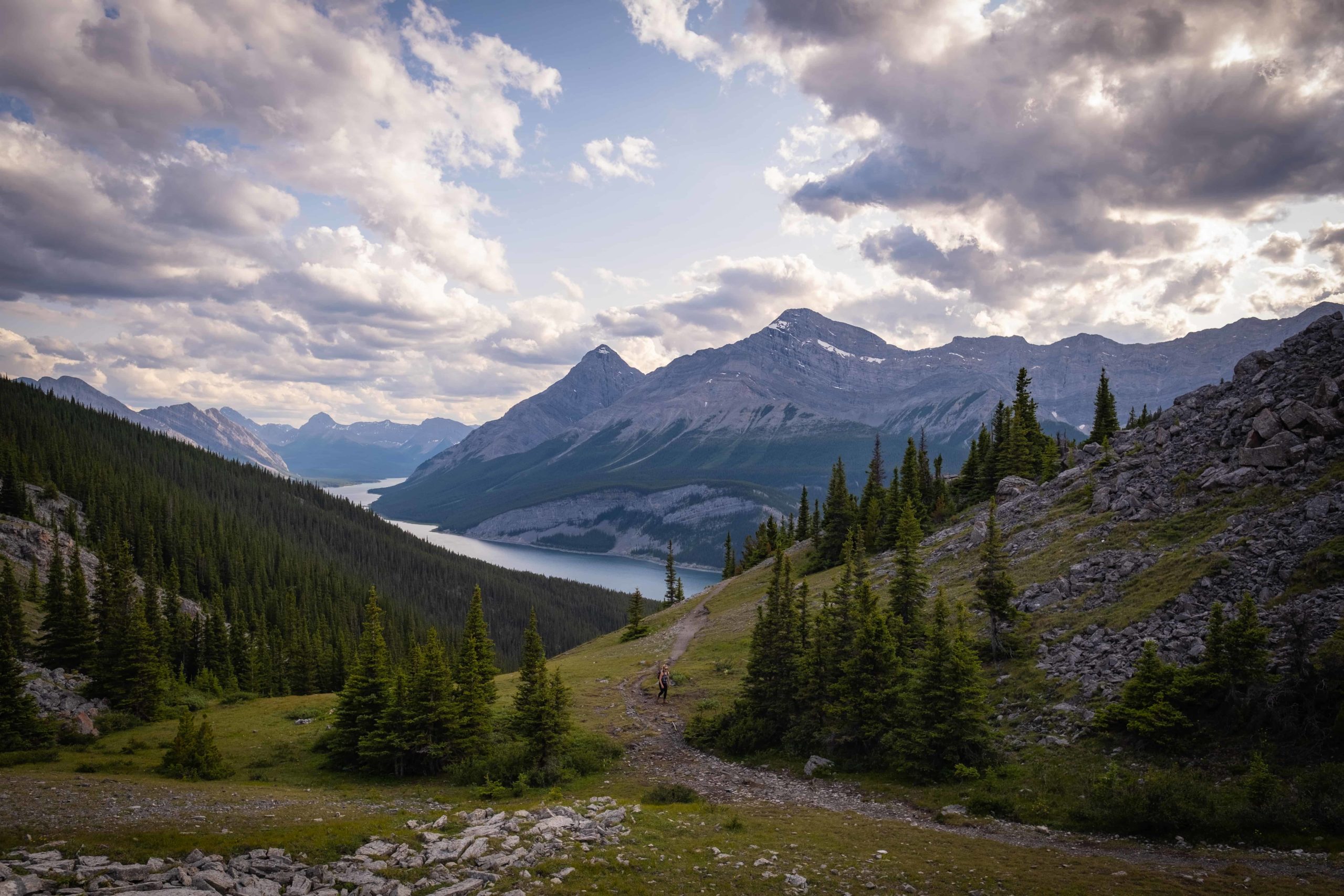
It’s best to avoid or be aware of bears’ most active hours. During the summer, grizzly bears are most active at dawn, dusk, or night. Not that we’d advise hiking around the wilderness at night anyway. You must be especially mindful if you plan to hike around these hours.
We love to hike at sunset to capture better photos, which often means heading down a mountain in bear country at dusk, so we make sure to be extra aware. If you’re new to the area and hiking and still learning to navigate, our best advice is to avoid hiking during these hours altogether.
Stay On Trail
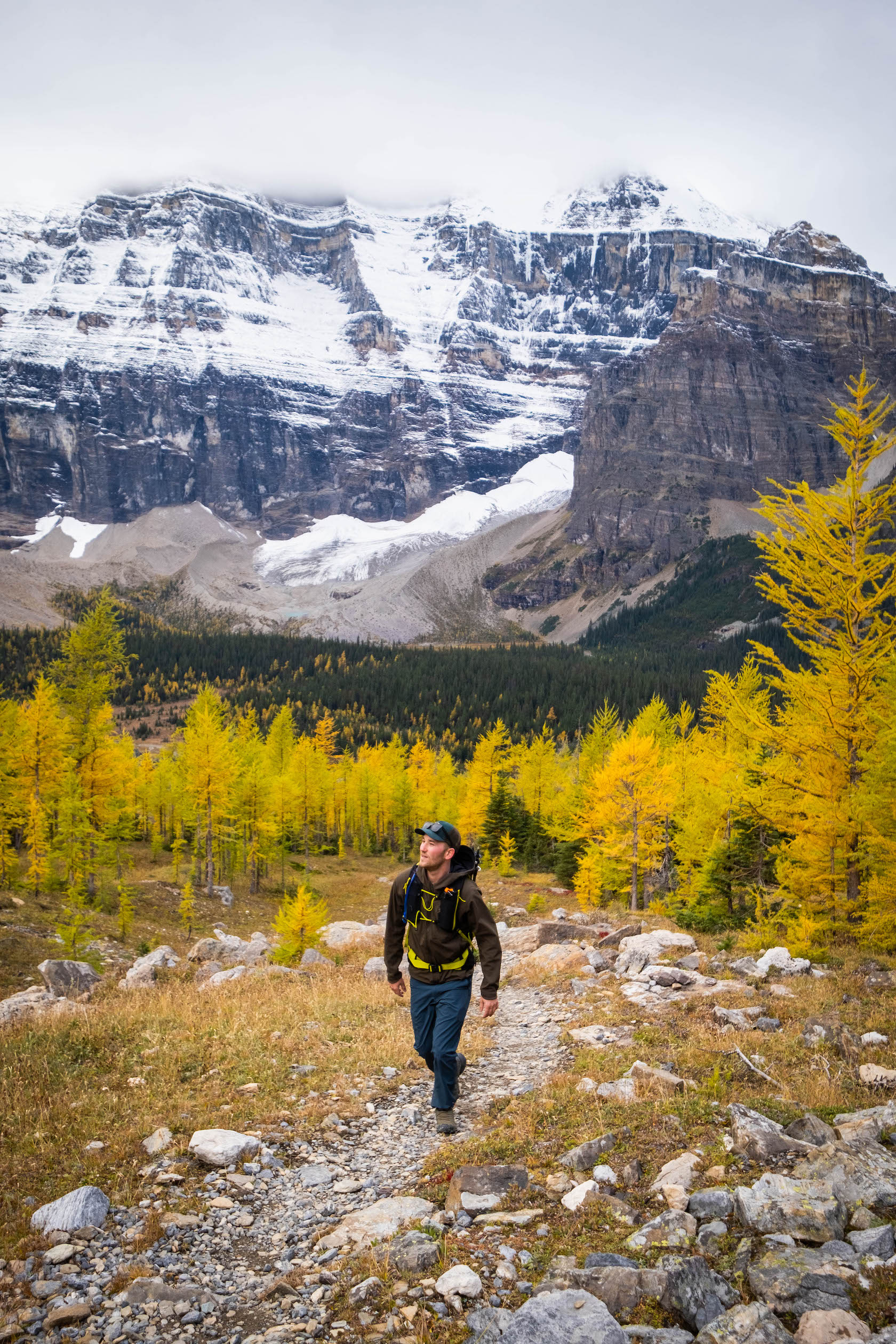
Visitors should stay on the designated trail, as this reduces the chance of bear encounters and is a good “leave no trace” rule. Bears are intelligent and know areas frequented by humans, so they often avoid busy trails.
Animals Should Remain On Leash
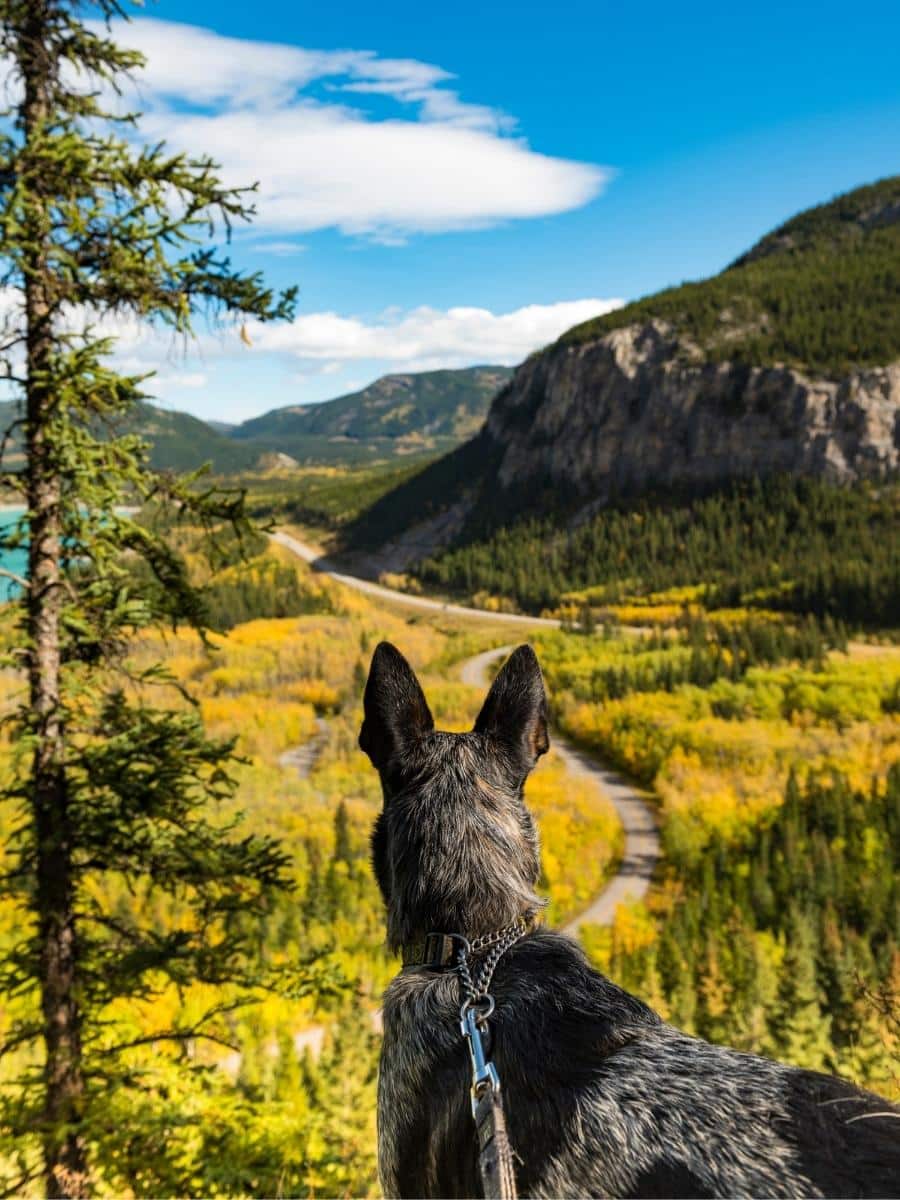
If you like to hike with your dog, remember that it should always remain on a leash. It is the law in parks that allows animals to enter, and this law is all about safety. A running or barking dog can trigger a predatory or defensive response from a bear or other predator. Proper bear safety requires a pet to stay on a leash.
In my first year living in the mountains, I can recall the local anger when a cougar was destroyed, as it was aggressive thanks to two hikers and their off-leash dogs. The result was two dead pets and a dead cougar. It’s an unnecessary negative interaction that could have been mitigated with a leash.
Notify Parks Authority
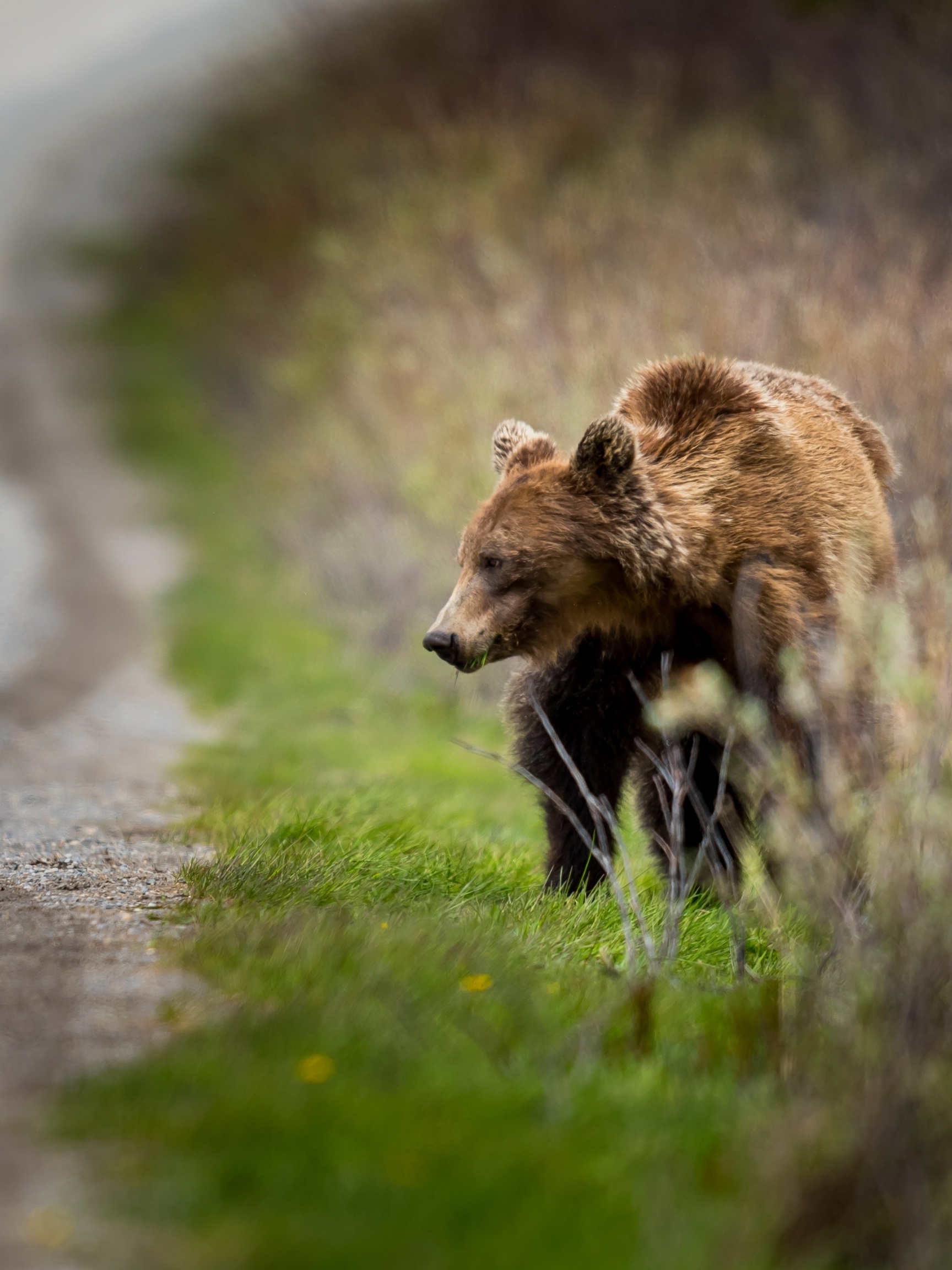
This goes along with what to do once bear spray is discharged. However, that is not the only reason to contact the relevant parks authority. It’s a good idea whenever the bear displays notable behavior such as curiosity, bluff charges, or any human interaction. If you see a bear rummaging through a pack or trash can, alert park authorities.
This does not only apply to bears, but any animal that may be a problem for visitors, such as wolves, cougars, or an aggressive elk. If you see a cougar, it’s probably best to alert parks no matter the circumstance, as tracking the animals is incredibly difficult. Parks have the power to close trails, and they should when there may be a predator in the area.
In years of hiking in bear country, I’ve encountered only a handful of notable wildlife encounters. I’ve seen plenty of animals, but only two were cause for concern, and that’s the case for most people. The most likely scenario is that you see an animal, and it carries on with its day at a distance.
“Bare” Campsites
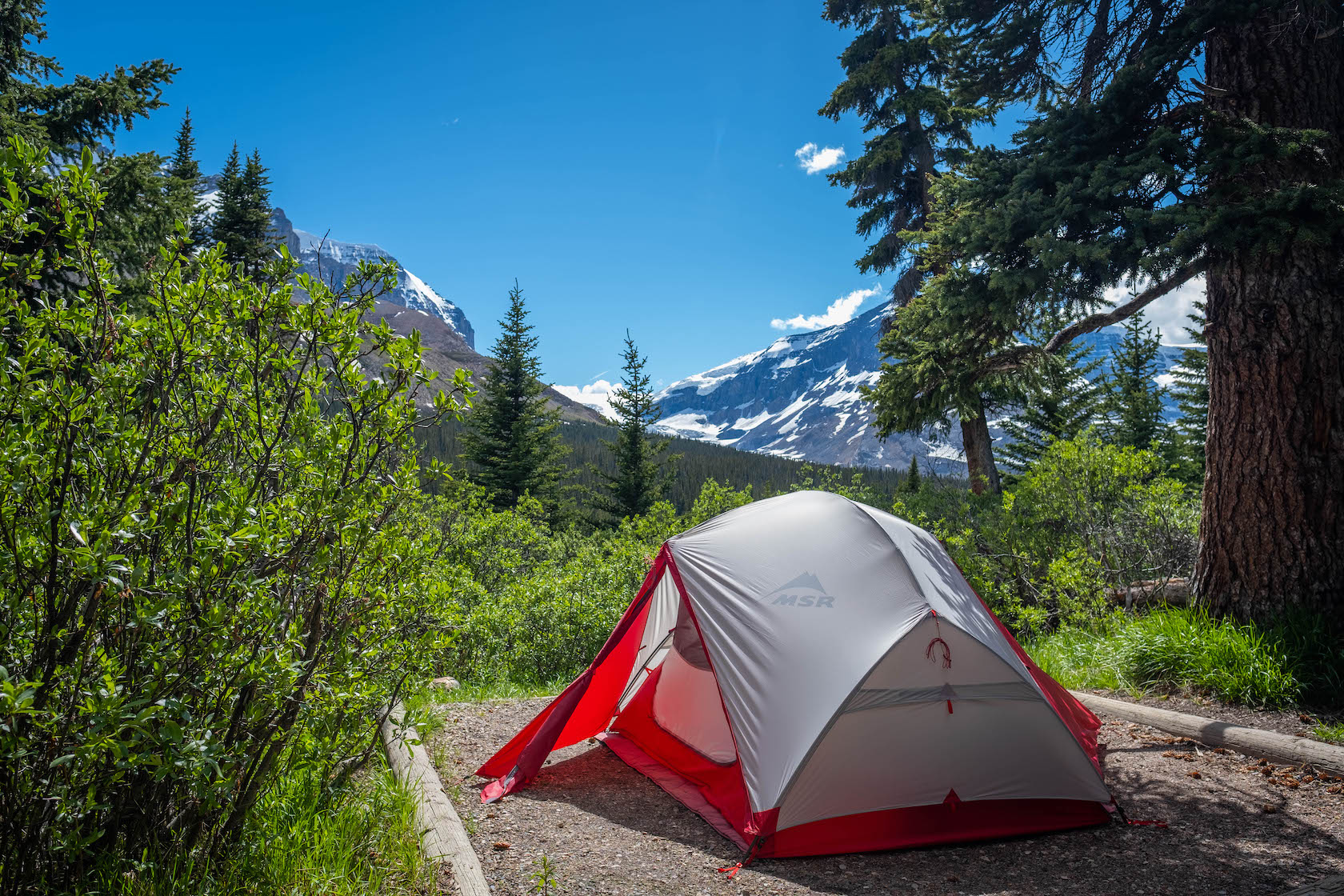
All visitors are advised to practice the bare campsite policy. This means no food is left unattended, and all campsites are clean to reduce conflicts with wildlife.
Food should be stored appropriately in bear lockers and away from the campsite and it’s advised to never keep or eat food in your tent. There have been multiple instances in history of habituated bears entering tents searching for food. Using canned or dried foods may be beneficial as they have fewer odors.
Cooking, cleaning, and disposing of dishwater should also be done 100+ meters from your tent. You should carry bear spray and a flashlight when wandering around your campsite at night. You can read more tips and information about camping in Banff National Park here.
How To React When Confronted With A Bear
Bear In The Distance
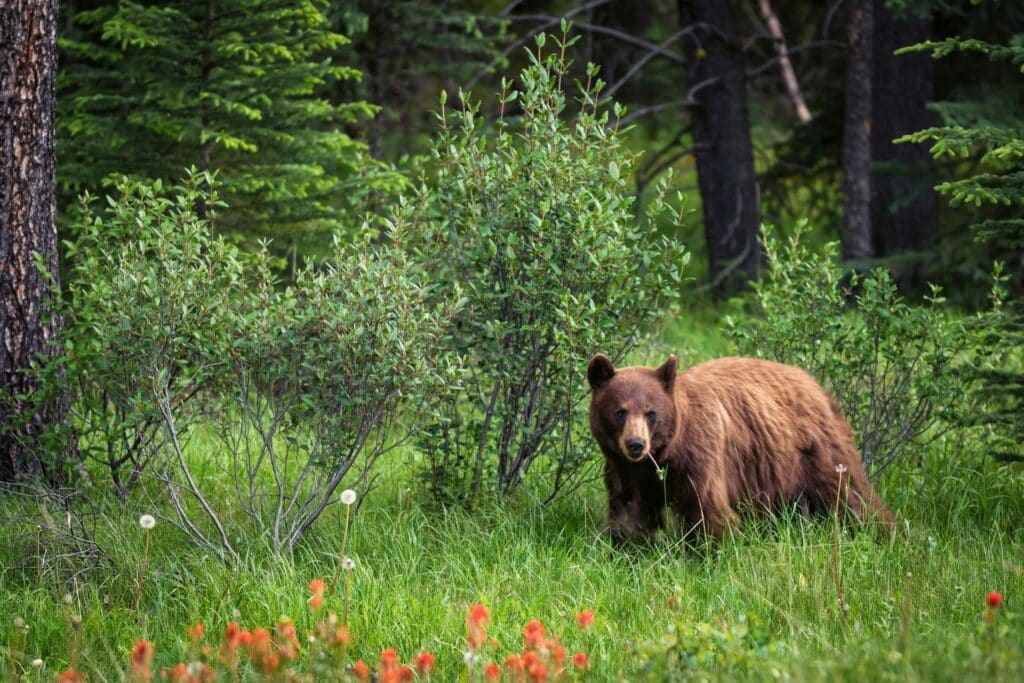
This is how the vast majority of bear interactions will occur. It’s an incredible encounter with a bear, and it’s extraordinary to see the animal in its natural habitat. However, distance should be maintained. It’s easy to get caught up in the moment and want to approach the bear for a photograph. However, there have been multiple instances of photographers approaching a bear and being mauled or killed.
If the bear doesn’t see you, remaining out of sight and downwind is best. You should detour around the bear as far as possible. A detour may involve leaving the trail as bears are often seen on the trail as it’s an easy path. If a bear is blocking your exit from an area, keep a considerable distance and make yourself known to the bear by yelling or moving upwind to allow the bear to catch your scent.
If a bear spots you, it may stand up on two legs. This is not aggressive behavior. The animal is likely using the higher stance to gain information, do not panic. Running away or moving quickly from a bear is never good. Make your intentions clear and move away slowly and straightforwardly. It’s important that you always leave the bear an escape route.
Startled Bear
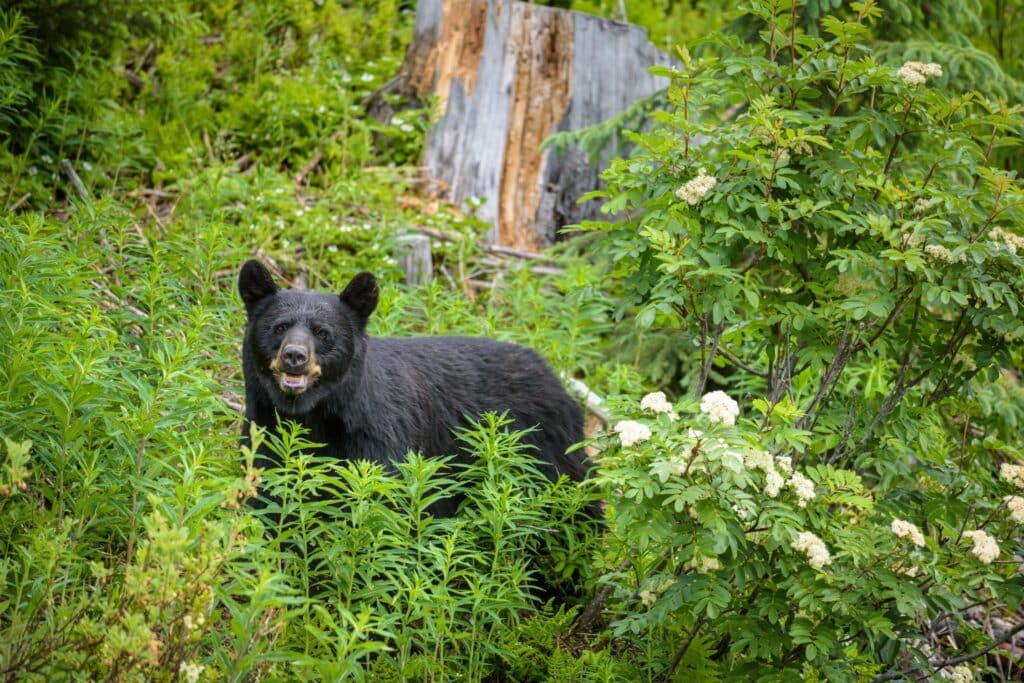
If a bear sticks out its lips, huff, barks, clacks its teeth, or slaps the ground, it is a warning sign that you are too close for the bear’s comfort. Listen to the bear and back away slowly. Do not run, play dead, shout, or make sudden movements. You do not want to challenge the bear or trigger a predatory response.
Continue to face the bear and back away slowly. It is important that you stay calm. Most bears do not want to charge you but react because they are defensive. Pick up any small children or animals.
You can talk in a low, assertive manner, but do not yell. Putting distance between you and the bear may calm the animal. However, draw your bear spray and remove the safety tab as you do so. You should be prepared to discharge the deterrent if the bear charges.
Do not run and do not climb a tree. Bears, especially black bears, are skillful climbers and have pulled several people from trees in attacks. You’ll likely not reach a height out of a bear’s reach before it catches you. One of the last bear deaths in the Canadian Rockies occurred when a local woman ran and climbed a tree.
Charging Bear
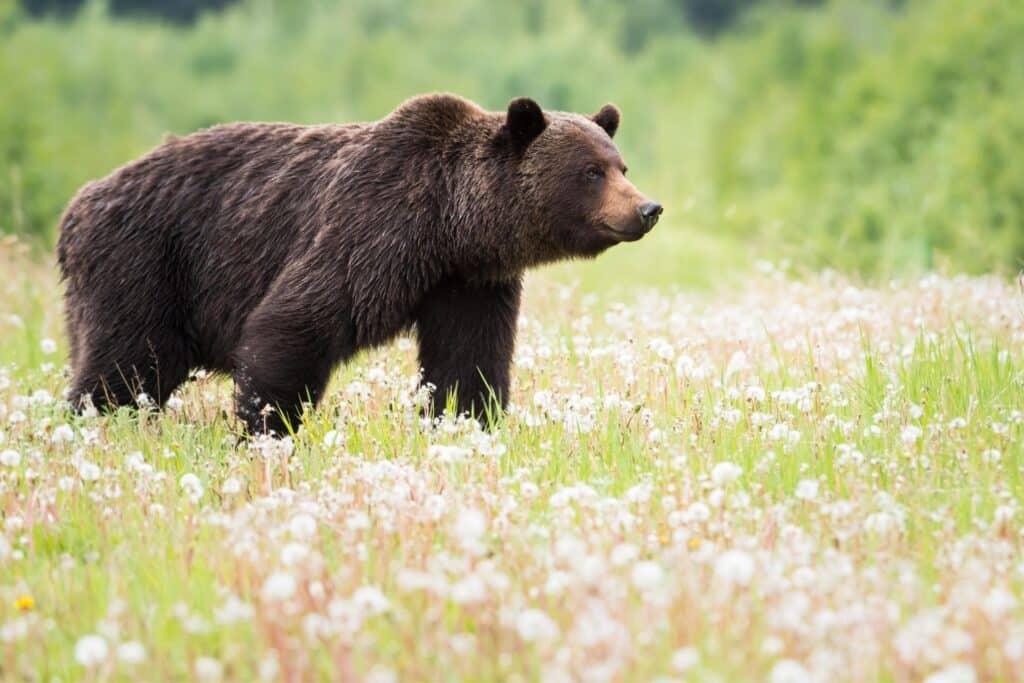
Stand your ground if a bear charges you after a surprise encounter. Most charges are a bluff, and the bear will stop the charge or veer away. If you turn and run, the bear will likely give chase. A bluff charge usually follows defensive behaviors. It may charge with its ears and head up to appear more intimidating.
This is the time to use your bear spray. Start spraying when the bear is around 15-20 meters. You want to create a cloud of spray about 10 meters away. When the bear enters the cloud, it will disorientate the bear and hopefully cause it to leave the area. Bear spray is 98% effective, so the encounter will likely end there.
Should the bear continue its charge, or you fail to use your bear spray, do not drop to the ground and play dead until contact with the animal or a moment before. To play dead, lie belly on the ground with your backpack up and clasp your hands around your neck with your elbows protecting the face. Stay still and silent to convince the bear you are no threat.
After the bear leaves, remain still for several minutes before you start to move again. Stay vigilant and cautious to ensure the bear has left the area. A grizzly sow may stay in the area as she gathers her cubs. If you get up too soon, she’ll likely attack again. Once you are sure it is safe, leave the area slowly, do not run.
When the bear reacts defensively in a surprise encounter, you should never fight back. A fight will only prolong an attack that you stand little chance of winning. People who have played dead during a surprise bear encounter have only received minor injuries 75% of the time. While those who fought back received severe injury 80% of the time.
Curious Or Predatory Bear
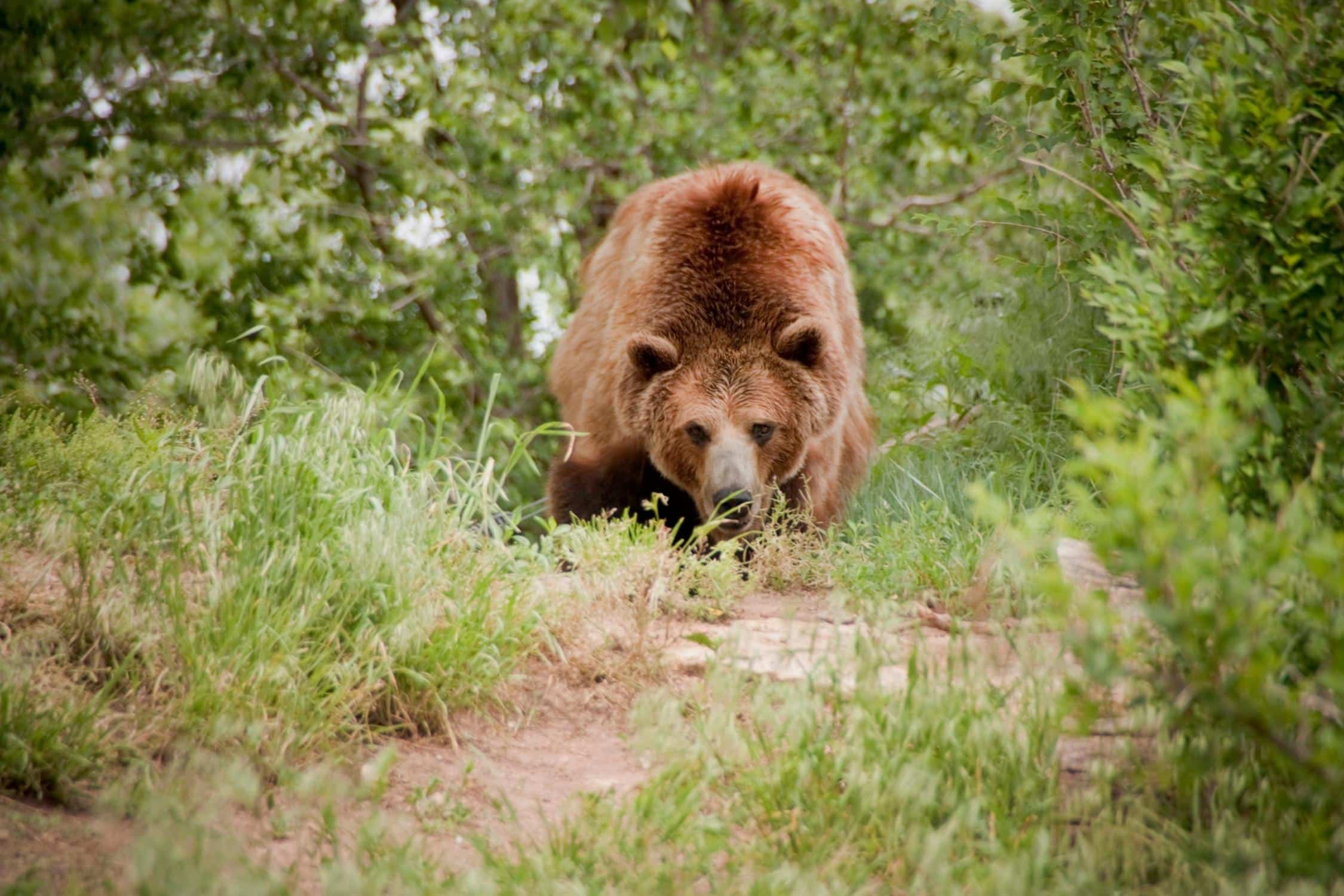
This is the least likely bear encounter, but it is vital to note. A curious or predatory bear may persistently approach with its head up and ears erect. It may not give any warning signs like a startled bear. It moves directly towards you in a calm manner.
If you’re approached by a curious or predatory bear, grab your items, especially food, and move away from the animal. DO NOT RUN. Stay facing the animal. If a retreat is not an option, gather in a group and yell at the bear. It may still turn around. If a bear is slowly approaching, prepare your bear spray and discharge when the animal is much closer, approximately 7 to 10 meters.
A predatory bear will charge with its head low and ears back ready to charge. It is no longer attempting to appear big and intimidating. If you are attacked by a curious or predatory bear, you want to fight back with everything. Your life depends on this fight, so utilize everything you have, rocks, sticks, a hiking pole, or a knife. Predatory attacks will continue until the bear is scared away, injured, or killed.
Grizzly/Brown Bear
There is a caveat to grizzly bear attacks: There is little chance of winning a fight against the animal. Your best bet is to play dead. However, if the attack continues for 1-2 minutes, fight back with everything you have.
Black Bear
If a black bear attacks and makes contact, you should fight back. Throw punches and kicks to the animal’s face and inflict as much damage as possible. There is a chance to scare off a black bear attack.
Myths Around Hiking In Bear Country
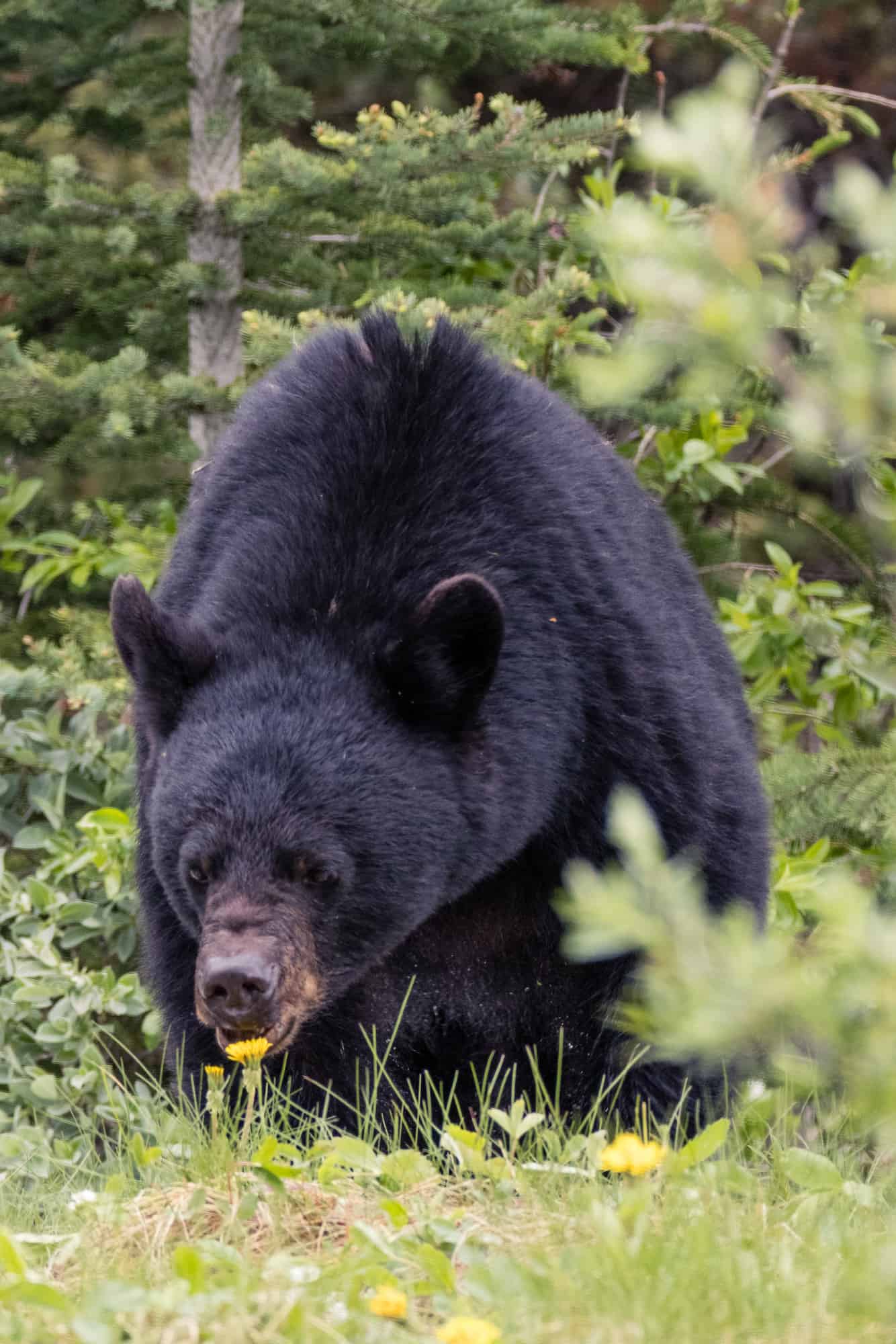
Bear Spray Is Not A Deterrent
This has to be said because a mistake is made every year, but the bear spray is not like insect repellent. Do not spray it on yourself. It is a powerful pepper spray. Anyone who has sprayed or accidentally discharged the repellent can attest to how powerful and painful the product can be on the skin and eyes.
Food For Day Hikes
You don’t need to worry about packing certain types of food in your pack on a day hike. Bears are opportunistic omnivores. They will eat whatever food source is most bountiful and easy. They require a vast amount of calories and sleep for half the year, so most of their activity centers around food, which is not necessarily human food. A sandwich in a backpack is far less appealing than a large thicket of ripe berries.
Bear Bells Or Speakers
There is a debate whether bells may be attractant or ineffective, either way, they’re useless in most settings. A slight ringing bell does not carry noise far, and it’s easy to be drowned out by a creek or wind blowing in the forest. There is debate about whether the unnatural sound may attract curious young bears. Bears are predisposed to avoid the human voice, not the sound of a small ringing bell.
Speakers are obnoxious to other hikers and drown out the nature you’re there to enjoy. Like the bear bell, the noise carries far less distance than the human voice. Of course, you could turn the volume up, but that makes a point of not enjoying nature and annoying everyone else on the trail who are there to enjoy the sounds of the birds and the bees.
Things to Remember About Bears in Alberta and BC
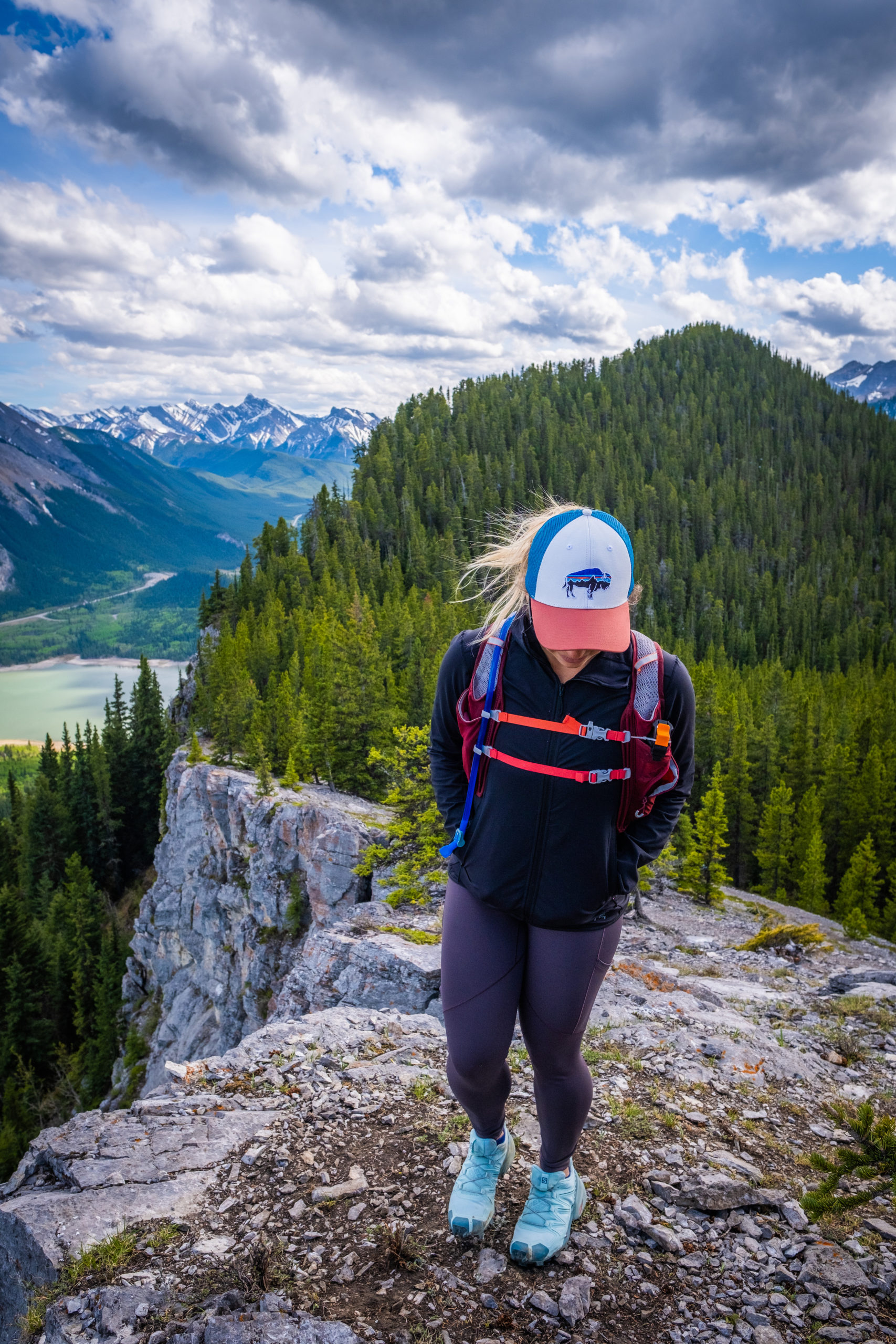
- In the spring, summer, and fall, bears need to eat enough to survive winter, when they spend between four and six months in their dens.
- Bears can consume up to 25,000 calories a day! However, most of their diet is actually low in calories—the natural diet of a bear is 85-90% plants and berries and 10-15% insects and mammals, meaning they are almost always eating.
- Bears have good memories and can remember where and how to access food in human-use places. They are also very smart and can apply many skills and tactics to get food almost anywhere.
- Bears are most active at dusk, night, or dawn, and you are more likely to run into one of them at these times.
- You also stand a higher chance of encountering a bear when you pass through berry patches where bears might be feeding.
- Due to its speed and quietness, biking increases the chances of a bear encounter, especially when coming around blind corners.
- Never abandon, bury, or partially burn food scraps when camping. Bears will be able to smell this.
Plan Your Trip to the Canadian Rockies
- We now have an interactive map! With over 350 stops and pre built itineraries around the Canadian Rockies, our personal map and guide is your one stop shop to an epic trip here.
- Recommended Experiences: There are many things to do in the Rockies, but our top recommendation is the Banff Gondola – a must do experience! Want to get up close and personal with a glacier? We cannot recommend this Icewalks tour enough!
- Planning your visit to Moraine Lake and don’t want to deal with the Parks shuttles? We recommend using Moraine Lake Bus Company, Fairview Limo (leaves from Lake Louise Village) or booking with ViaVia (these leave from Banff/Canmore).
- Hotels in the Rockies: There are many places to stay, from luxury hotels to wilderness cabins. See all our favorites here.
- Get Around: We suggest renting a car to get around. You can search for rental cars on Discover Car. For a campervan trip, you can check prices and compare on Outdoorsy.
- We can help you plan your 2025 trip to Western Canada! If you’re feeling overwhelmed by planning we can assist! We’ll hop on a 1 on 1 phone call, and PERSONALLY go over your itinerary, and will save you previous time and money with our personal recommendations. Calls are followed up with detailed trip notes afterward that I write myself. See our services here.

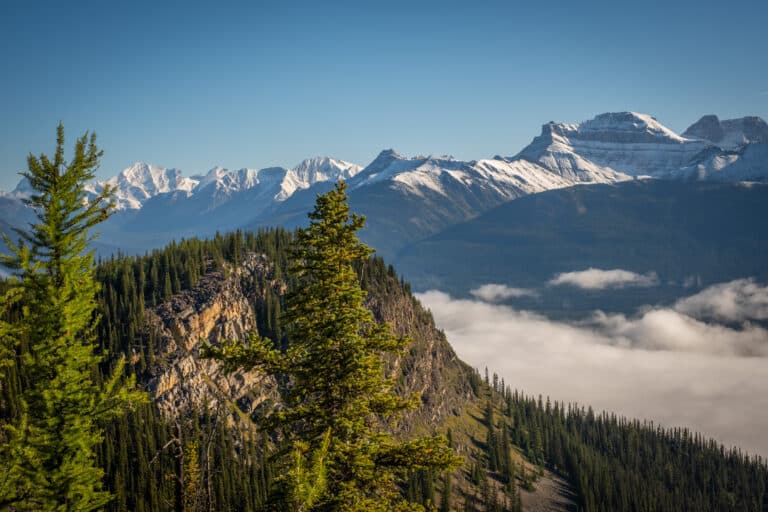
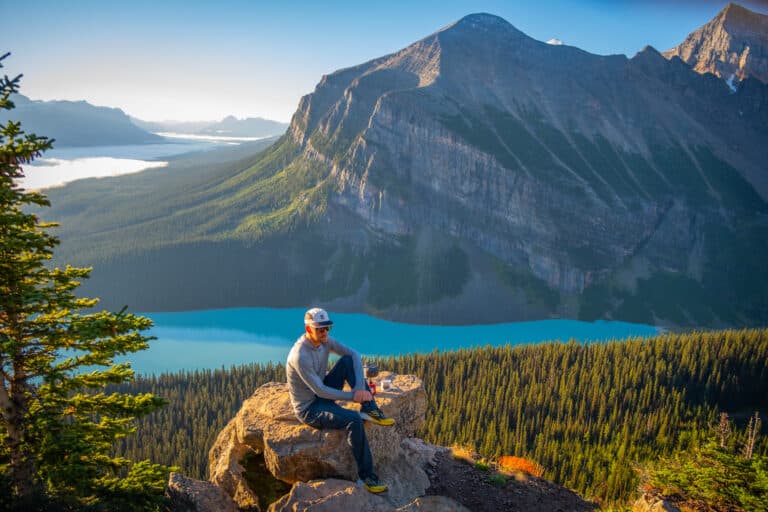
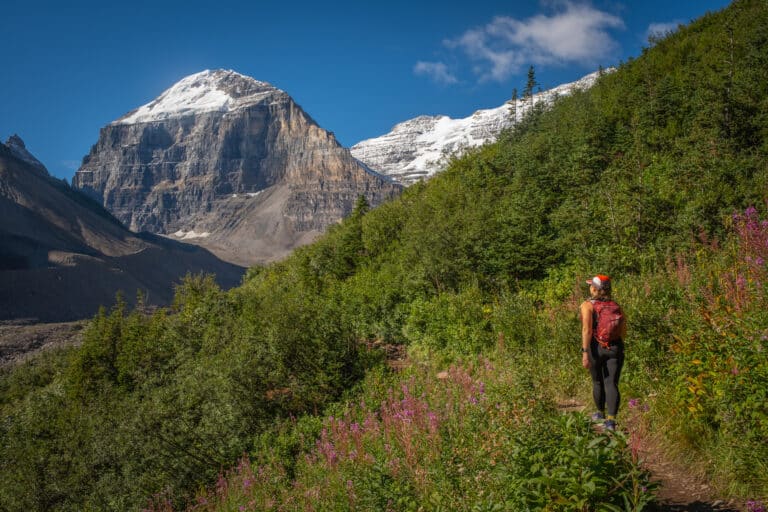
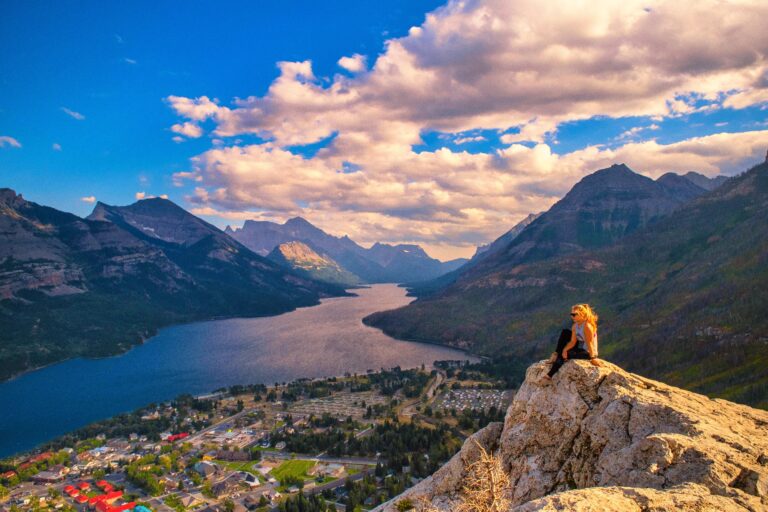
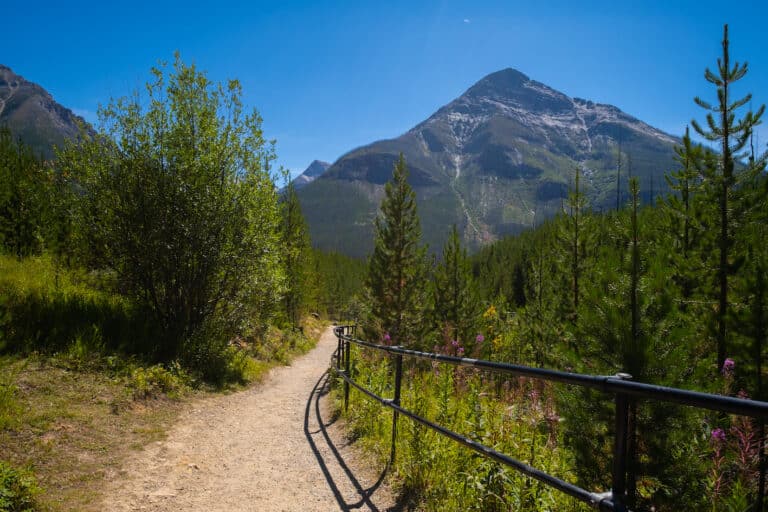
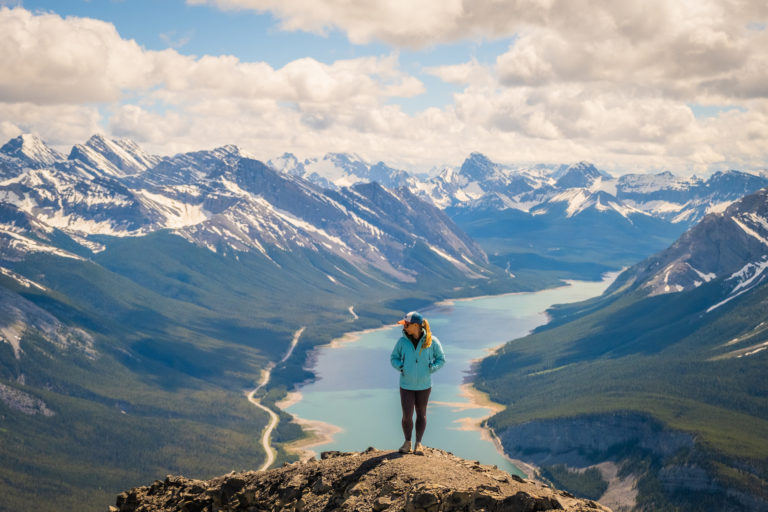

Where is the picture taken under the heading “Stay on the trail?”
Very helpful information
We will use it this summer while hiking in Banff and Jasper parks
Thank you
Tim
I’m planning a trip with my family this June and am paralyzed with fear over a bear encounter. If we stay in busy areas, are the chances of seeing a bear minimal or could it still happen?
If you stay in busy area (Johnston Canyon, Moraine Lake, Lake Louise, etc) it’s definitely unlikely you’ll see bears, but it’s still always possible. Though unless you’re doing lots of hiking, your chances of a close up bear encounter are very minimal. Most visitors see them from the car. We are out and about nearly every day hiking, biking, and walking and have only run into a bear on the trail a few times in the past few years.